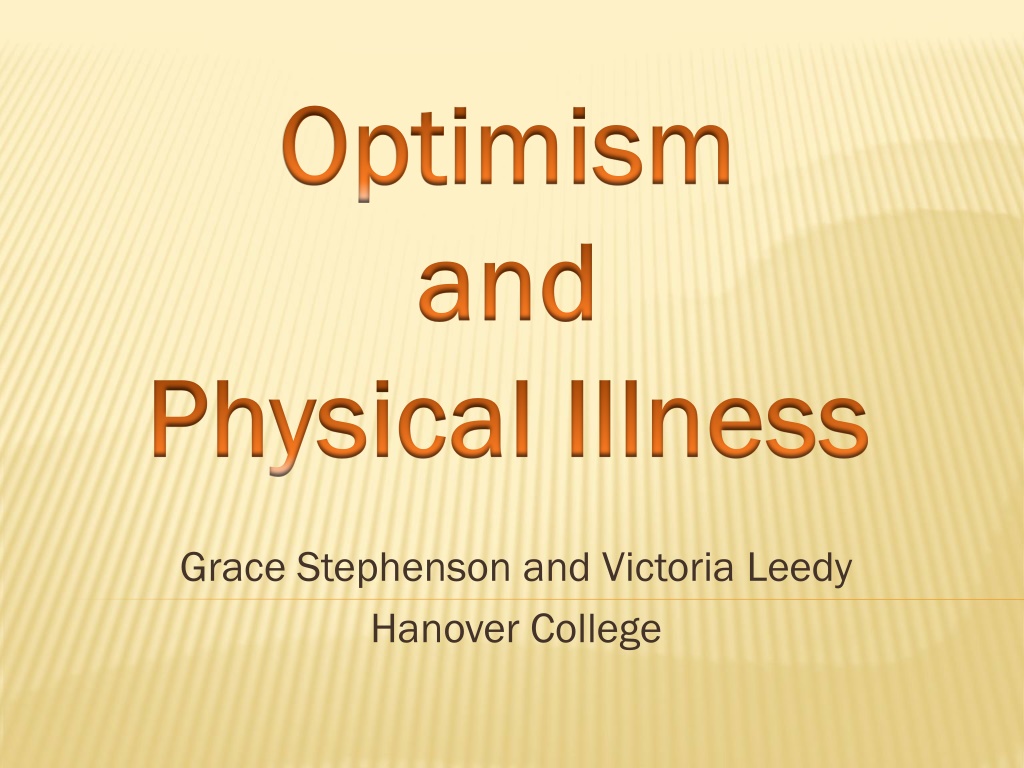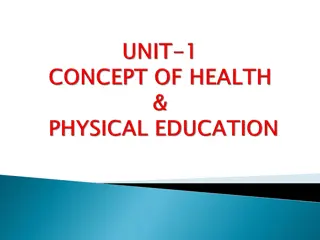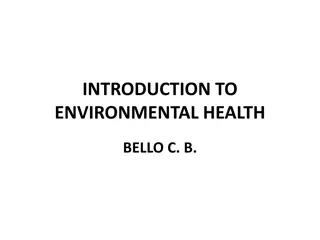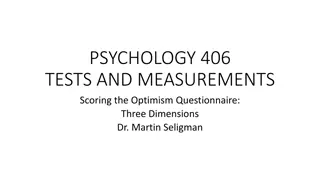The Power of Optimism in Improving Physical Health
Explore the profound impact of optimism on physical health as evidenced by research studies linking positive thoughts to reduced cardiovascular illness and faster recovery rates. Discover how manipulation of optimism through writing exercises can lead to significant improvements in overall well-being. Hypotheses and participant demographics further underscore the importance of a positive outlook in promoting health and resilience.
Download Presentation

Please find below an Image/Link to download the presentation.
The content on the website is provided AS IS for your information and personal use only. It may not be sold, licensed, or shared on other websites without obtaining consent from the author. Download presentation by click this link. If you encounter any issues during the download, it is possible that the publisher has removed the file from their server.
E N D
Presentation Transcript
Optimism Optimism and and Physical Illness Physical Illness Grace Stephenson and Victoria Leedy Hanover College
Can positive thoughts really create a healthy life?
OPTIMISM Dispositional Optimism The expectation of positive outcomes (Scheier and Carver, 1982)
CORRELATIONAL RESEARCH Positive association between optimism and reduced cardiovascular illness Boehm and Kubzansky (2012) Dispositional optimism is associated with a faster rate of recovery from coronary artery bypass surgery Scheier et al. (1989)
OPTIMISM AND CARDIOVASCULAR HEALTH Optimism measured at one point in time is related to CVD and CVD-related mortality years later even after controlling for CVD risk factors and depression. Giltay et al. (2004) Giltay et al. (2006) Tindle et al. (2009)
A MANIPULATION OF OPTIMISM The Best Possible Self: a manipulation of optimism through writing exercises King (2001) An observed sustained increase in optimism from the BPS intervention Meevissen et al. (2011)
A POSSIBLE MEDIATOR How does optimism provide protection against illness? Elevates positive affect King & Burton (2009)
HYPOTHESES 1. Participants in BPS condition will show a significant increase in optimism and a decrease in illness. This decrease in illness will be greater than the decrease experienced by participants in the CE condition. 2. Participants in the CE condition will show a significant decrease in illness. 3. Participants in the Control Condition will experience neither an increase in optimism or a decrease in illness.
PARTICIPANTS Total: 31 Per Condition: BPS- 52% Challenge- 23% Control- 25% Gender Male- 19% Female- 81% Age 18-23 years old Ethnicity Caucasian- 77% African-American- 6% African 10% Unknown 6%
MATERIALS Revised Life Orientation Test (LOT-R) to measure dispositional optimism Scheier, Carver, & Bridges, 1994 Examples: I rarely count on good things happening to me It s important for me to keep busy Overall, I expect more good things to happen to me than bad 1-4 Likert scale
MATERIALS PILL Scale to measure self-reported illness Pennebaker, 1982; Pennebaker & Beall, 1986 Examples: Running nose Indigestion Insomnia or difficulty sleeping 1-4 Likert scale
PROCEDURE Communicated through email Participants randomly assigned to one of three conditions: BPS, Challenging Event, Control Subjects completed baseline questionnaires: Optimism Scale
PROCEDURE, CONT. Participants wrote every day for 4 consecutive days Every week thereafter for 3 weeks, participants completed optimism and illness scales
PROCEDURE, CONT. BPS Writing Prompt Think about your life in the future. Imagine that everything has gone as well as it possibly could. You have worked hard and succeeded at accomplishing all of your life goals. Think of this as the realization of all of your life dreams. Now, write about what you imagined. King, 2001
PROCEDURE CONT. Challenging Event Writing Prompt Looking back over your entire life, please identify and describe what you now consider to be the greatest single challenge you have faced in your life. What is or was the challenge or problem? How did the challenge or problem develop? How did you address or deal with this challenge or problem? What is the significance of this challenge or problem in your own life story? (McAdams, 2008)
PROCEDURE CONT. Control Writing Prompt Write about what you did today. Go into as much detail about your activities as possible. Do not focus on your emotional experience, but rather the sequence of events. As you write, do not worry about punctuation and grammar. King, 2001
DISCUSSION Participants in BPS condition will show a significant increase in optimism and a decrease in illness.
DISCUSSION Participants in the CE condition will show a significant decrease in illness.
DISCUSSION Participants in the Control Condition will experience neither an increase in optimism nor a decrease in illness.
LIMITATIONS Lack of participants Unequal participants among conditions Lack of controlled environment Deviation from schedule
FOR ADDITIONAL RESEARCH Compare hand written and typed responses Only conducted in controlled environment Different age groups People who have recovered from life- threatening illness
RESULTS: OPTIMISM AND ILLNESS ACROSS CONDITION
INTRODUCTION, CONT. Self-efficacy: belief in one s capabilities to organize and execute the course of action required to produce given attainments Shift from biomedical model to more biopsychosocial model over previous years Many impairments today can be eliminated by the individual because they are choices
DROP OUT RATE BPS: 24% Challenge: 22% Control: 33%
EXPECTED RESULTS Illness Illness High SE Low SE BPS Challege Control























